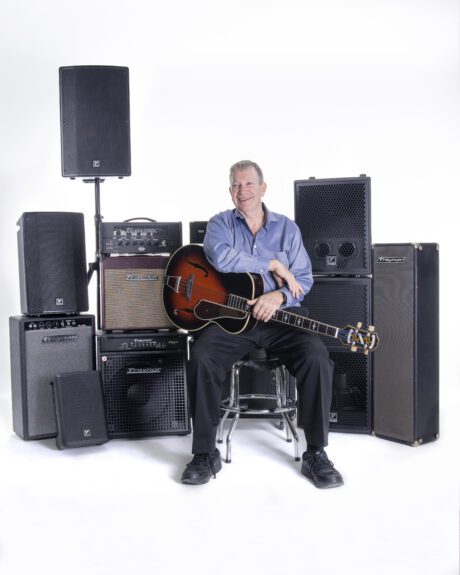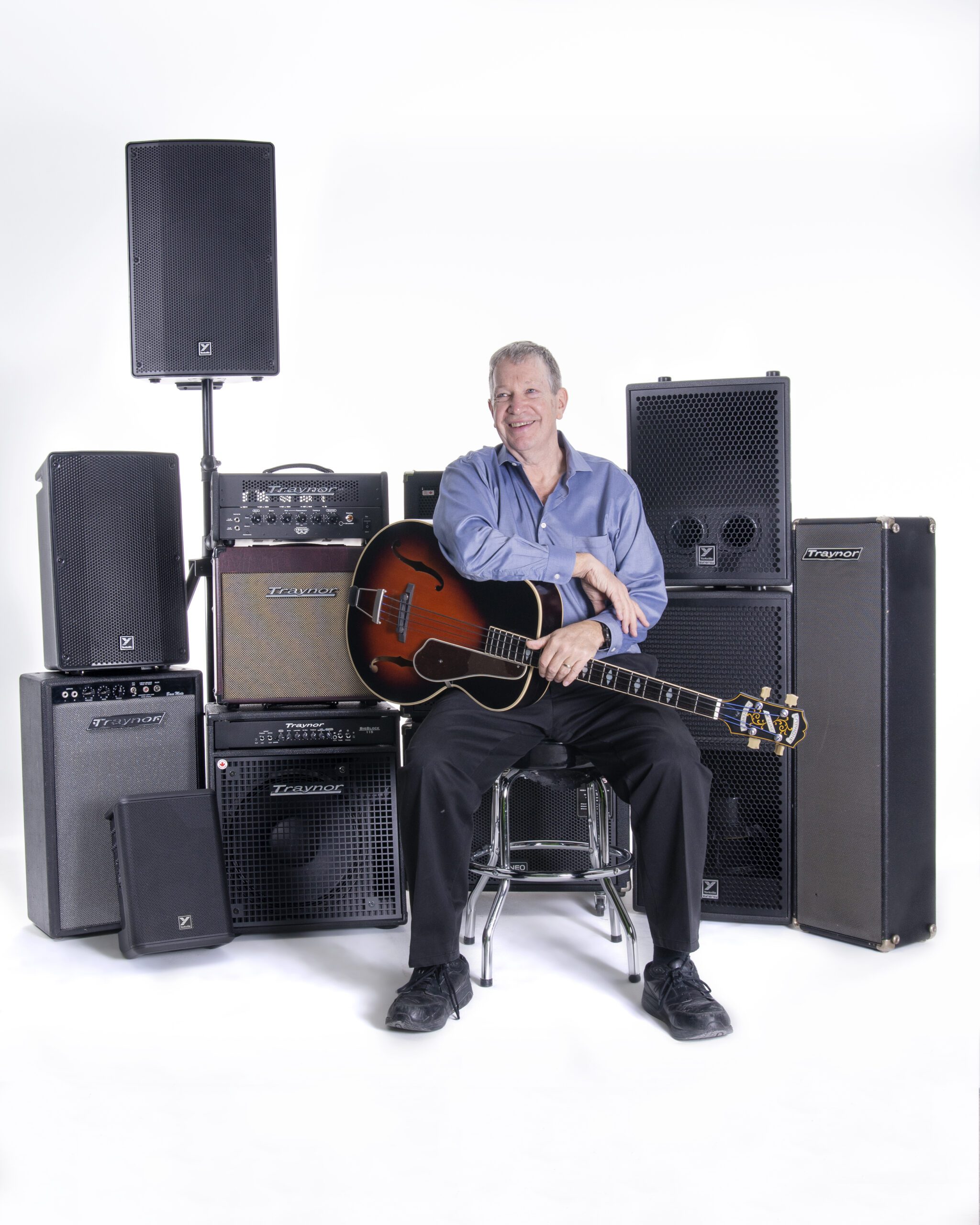
In 1963, in the repair room of the original Long & McQuade Music Store in downtown Toronto, Peter Traynor designed and built the Dyna-Bass amplifier, a relatively affordable unit specifically developed to withstand the abuse of the road and rentals. Soon afterwards Traynor and co-founder Jack Long officially launched Yorkville Sound.
Today, the company fields a full line of professional PA products, including loudspeaker cabinets, portable lighting rigs, mixers, and amplifiers. Additionally, within the larger “Yorkville umbrella,” are Traynor Amps, ART Pro Audio, Apex Electronics, Orion FX Lights, and VTC Pro Audio, serving a wide array of market segments within the MI landscape that have been embraced by musicians and sound engineers the world over.
MMR recently sat down with Yorkville CEO Steve Long to discuss the organization’s first six decades, some of the key product introductions and events that have shaped the brands along the way, and how the company’s core mission statement of building durable, quality products at competitive price-points has guided every step along the way.
After Peter Traynor developed the Dyna-Bass amplifier, how and why did he and Jack Long decide to take it further and actually form a standalone company rather than having this new venture exist within Long & McQuade?
Well, I think if you go back to those days, which was the ’60s obviously, [MI gear] was way more expensive than they are now. Like, a Fender amp was probably a similar price to what it is now. So, it was pretty easy to just put the pieces together and make an amp, and it was kind of like, “Well, the amp [sells for] $600 and if you add all the pieces up, it comes to $150, so we can sell it for $300 and still make money, right?” So that was kinda how Peter came up with the idea. He was a repair guy and he was like, “You know, I could put these things together and we could sell them.”
So, the first thing they actually made was a pair of speaker columns and they put them in the store and sold them. And then, “Oh, we’ll make another pair.” And that was kind of how it started. I think, originally, my dad was more the business guy, and Peter was more the idea guy. They just kind of came to the conclusion, “Hey, I think we can do that, right? We can make some money with this.” So that’s how we started.
I lived briefly in Toronto and I’m curious: was the name Yorkville chosen because of the Yorkville neighborhood of Toronto?
Well, that’s kind of a funny story because, you know that whole thing where Yorkville became a really cool scene and all that?
Yeah, yeah.
That hadn’t happened yet, right? But when you stood outside of the old store at 803 Yonge Street, when you looked across the street, the street that went off of Yonge going the other way, not the side that the store was on was called Yorkville Avenue. So they were trying to think of a name for the company. You remember the game when you were a kid and you’re coming up with a band and you’re like, “Okay, what are we going to call our band?” It was kind of like that game, right? What are we gonna call our band? So they were standing outside and they saw that sign and they thought, “Oh, we should have ‘sound’ in the name so, something like ‘Toronto Sound,’ or whatever.” And then they saw the sign Yorkville, and it was “Hey, Yorkville Sound. That’d be cool.” And that’s how it became Yorkville Sound. And then later Yorkville became this big cool area and the hippie scene and all that stuff, but that was all after the fact.
Back in ’65 when Yorkville Sound was incorporated back at the beginning, how many employees were there total?
Well, I mean, originally there was just Peter, right? But when I was a kid and the original facility was upstairs at the store, there were about six employees. In the late ‘60s, the first real building was on Dundas Street and right by the Don Valley Parkway, which is sort of downtown Toronto, really. You wouldn’t make a factory there now, but back then Toronto was not what it is now. And it might have been, I’m guessing, 8,000 square feet.
Skipping ahead to the present day, how many are currently employed by Yorkville and how large is the headquarters?
So now we’re at about 250 employees and we’re about 140,000 square feet. We’re in Pickering, which is the east side of Toronto.
Can we talk a little bit about the acquisition of is it ART Pro Audio or ART Pro Audio in 1999?
ART stands for Applied Research and Technology, and that came out of MXR. They were in Rochester and we were the Canadian distributor at that time. They kind of went out of business and then reformed as ART. We originally got involved with them in a bigger way. We were manufacturing a product called the Proverb, which was an original, rack-mount digital reverb. They weren’t very well run from a financial point of view, but they had a lot of good product ideas. They kept running into financial trouble and that’s how we ended up kind of buying them.
Within the larger Yorkville umbrella, you guys also have Orion Lights, Apex, VTC Pro Audio, in addition to Traynor and ART. Can you talk about those other brands and when were they established and, again, why have separate brands and not just have it all under the Yorkville banner?
I think that we found, just from watching the industry, that there seemed to be a problem for companies with identities of brands. Just for example, Marshall never had any luck with PA programs. Fender never had much luck with PA. Gibson never had much luck with amps. So, for the most part, what we’d see is a company would get a reputation for something and then when they would try and come up with something else, it would never really translate very well, which was sort of the reason why we became with Yorkville and Traynor. It was like, “Okay, let’s try and keep an image.” So, all the things that people want in an instrument amp, we’ll try and make that in the Traynor brand, and all the things people want in the PA, we’ll make that in the Yorkville brand. And then all the other brands were sort of following in that thing where we’d say, “Okay, let’s not be handcuffed by the images of Yorkville when we’re trying to design lighting,” or whatever.
And I think the other thing is, we’re kind of a small deal in the U.S., but we’re a pretty big deal in Canada. So what often would happen in Canada is, if people get a certain image of your products and then you try and sell something that doesn’t fit with that image, it becomes a little tougher. We thought by having different brands for each product category, it would give us a little more freedom to market them separately and also to sell them to different people. It prevents muddying the waters and sort of cannibalizing from one another.
I understand what you’re saying about perhaps being a bigger brand in Canada, but I mean, Traynor’s a big brand down here in the U.S., too.
Yeah. It’s well known. One of the things is we’re sort of a victim of our own success in one sense, in that we’ve been making so many products for so many years, and they all last forever. So there’s a lot of Traynor out there, which is good. [laughs]
Things also are different in different markets as well. So, with a lot of the brands like Orion Lighting, we do really well in Canada, but it doesn’t really do a whole lot in the U.S. or exports. And then other brands, like VTC and Elite, do really well in the States. Being a Canadian company, Canada’s a small market, so you always have to kind of be able to make your living by selling a little bit of this, a little bit of that. And I guess that’s how our factory specialized in making 200 of something at a time. We can make smaller quantities, but still keep the costing reasonable because we’re very automated we’ve got a lot of tribal knowledge. Our staff are really good that they know how to make all the different things so we can make, say, 100 2×10 bass cabinets that’ll last us a year because 2×10 bass cabinets don’t sell that much, right? And then some of the bigger sellers we might sell at 500 at a time. But the PA is the bulk of the different sales compared to the instrument amps, but the instrument amps are also doing well.
From a marketing and just general awareness standpoint how important has it been that Yorkville and Traynor have both been embraced by high-profile artists and venues and tours?
Well, I think it’s been very important, especially in Canada because, in the U.S., I think we have a bit more of a boutique image because we’re not quite everywhere whereas, in Canada, we are everywhere and everybody’s played [with] our stuff. So one of the problems in Canada is Canadians don’t always accept Canadian things as a successful. So for us being in everybody’s face, the fact that there’s credibility and people in other countries and famous people use our stuff, then I think it sort of has given us more credibility.
Looking back over the past 60 years now, what would you say are some of the milestone product introductions, and milestone moments that really helped establish the brands and establish the company as a force within the music-making community?
It’s been a lot really. I think our tube guitar amps, the YCV Series has been very, very key because they’re very well respected. We’ve been making them for years and years and, similar to some of the Fender amps, they’ve become well established. So I think that’s important. We have a lighting system that is so easy to use that every musician in Canada uses them. And that’s been a huge product for us. It never really caught on in the U.S. and I think it’s only because in Canada there’s a huge rental market, so once people rent these a few times they’re like, “Wow, this is the answer for a lighting system that’s operated by the band.”
What lighting system is this?
Well, the current version is the LP-LED4, and nobody else makes anything like this. Everything else is kind of either really Mickey Mouse, or you need a guy to run it, and this is kind of in between. This is the system that you can operate from the stage and it does a good job, it’s small, it’s easy to set up, but it looks professional and it’s really unusual. And it’s interesting that it’s never really caught on in any other country.
Our subwoofers have been really, really well received in the U.S. market and around the world. And I think one of the things that we’ve always been very big on is reliability. When something gets rented, the amount it gets used is much, much higher than your average sold PA system, especially these days. I mean a lot of bands that are buying the smaller type PA systems are not playing every night, right? They might play a couple of times a month or whatever, whereas the stuff that’s rented is going out constantly. It’s getting used over and over and over by different people and being run harder than it needs to be run or should be run. So we’ve always been ahead of the curve on making products reliable in terms of almost, “You can’t break it.” It’s not like you can turn it up too loud and blow the speaker or whatever. We always protect for all those things. And subwoofers tend to be something that get blown because everybody wants more bass and they’re expensive and big. So people are generally don’t buy enough of them. You know, it’s, “Well, we really need six subwoofers, but we’ll just get two because they’re the size of my house.” Our subwoofers have always been way more reliable and better than anybody else’s. So I think we’ve always done a huge business in subwoofers everywhere and especially in the U.S., so that’s been I think a huge part of our business.
Are there any special product introductions or events or celebrations that you guys have planned to mark the 60thanniversary?
Yeah, we are planning a celebration, but the details are not yet worked out. They’re still looking at venues and artists and stuff like that, but right now it’s looking like it’ll happen in the fall, September, but these things change. I think a lot of our staff are very proud of it. We’ve had a lot of employees that have been here a long, long time. They’re a very stable workforce. We’ve always tried to run the company to be a good company – and by “good company,” I mean: make good products, treat the employees well, treat the customers well, and as long as we can do that and keep our head above water, we’re doing well. So the employees and customers are all a big part of our celebration.
Is there anything that you’d like to share with our readers either about the past 60 years or Yorkville’s hopes or plans for the future?
I think we just want to continue to be a good supplier and make good products that people can be proud of using and selling. We try to make everybody’s life easy. Like, we always try to service everything. You can still get parts for older products and because of our sister company, Long & McQuade. We know what the retailer needs and we try to provide those things for our customers. It’s a huge, huge advantage for us product-wise because we have all these staff members out renting stuff to people every week and people come back and say, “Oh, I need this to be louder,” or whatever the case may be. I really stand behind our products. I think our products are great and all of our staff in the stores are musicians. When we design things, all of our designers are musicians. So the products really go through a lot of people with professional ears and fingers and voices on the product. By the time it manages to work its way through the system, it’s good!
I’ll give you an example: we have a reliability test that we put all of our heavy-duty PAs not even heavy-duty, all of our PA systems on. The test is 700 hours at worst case. And worst case is different for different kinds of products, but if it’s a subwoofer, it’ll be running right at clipping for 700 hours. We have a cement fireproof building inside our building that we built. We actually have two of them. So we can put this in, we’ll run it for 700 hours, and the product has to live through the full 700 hours, right? If it dies after 200 hours, we go back to the drawing board, figure out, “Okay, what did we do wrong? What can we fix to make it last the 700 hours at least?” And then you think, “Okay, well, 700 hours doesn’t sound that long, I guess. Let’s take some of our competitor’s products and put them on this test and see how long they last.” Nobody even makes it past 10 hours.
Well, that speaks to the quality of the product.
And in this throwaway world these days, how many electronic things get fixed these days? Well, our stuff does because it lasts forever.
That’s a great sort of summary and also an aspirational goal for any MI supplier. Congratulations on this milestone year for Yorkville and best of luck going forward.
Thank you!




























